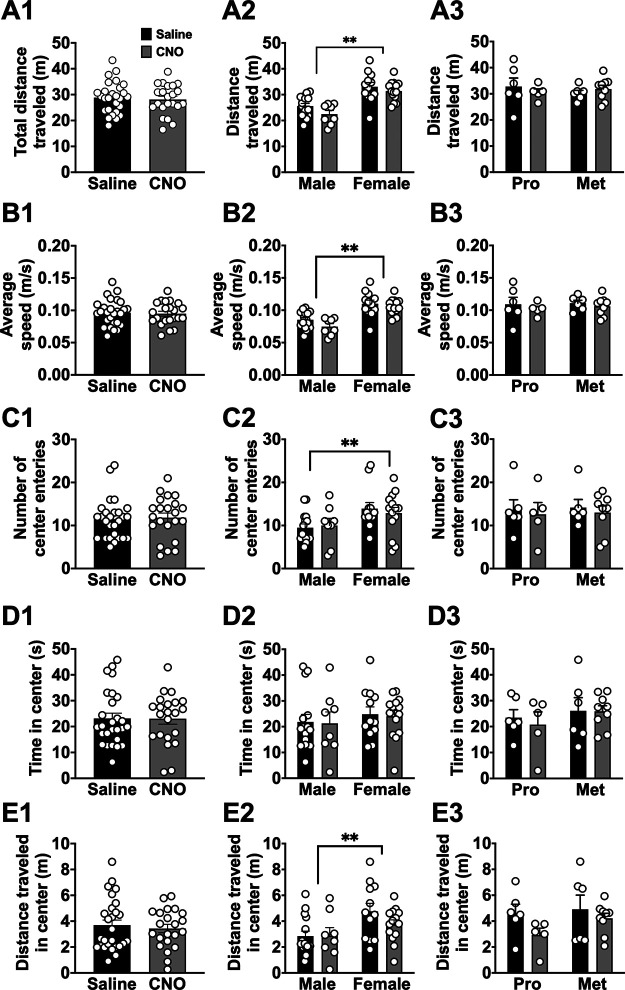Figure 6.
OF exploration is not affected by inactivation of BLA-BNST. OF exploration was examined in rats following either CNO (N = 22, gray) or saline (N = 27, black) injections. There were no significant differences in total distance traveled (A1; t(47) = 0.4362, p = 0.6647, unpaired t test), average speed (B1; t(47) = 0.2639, p = 0.7930, unpaired t test), number of center entries (C1; t(47) = 0.2722, p = 0.7866, unpaired t test), time spent in the center (D1; t(47) = 0.03786, p = 0.97, unpaired t test), and distance traveled in the center (E1; t(47) = 0.5061, p = 0.6152, unpaired t test) during the novel OF task. The same parameters were also analyzed by sex and drug treatment (N = 15 saline males, N = 8 CNO males, N = 12 saline females, and N = 14 CNO females). There were main effects of sex when total distance traveled (A2; F(1,45) = 39.56, p < 0.0001, two-way ANOVA), average speed (B2; F(1,45) = 39.37, **p < 0.0001, two-way ANOVA), number of center entries (C2; F(1,45) = 7.703, **p = 0.008, two-way ANOVA), and distance traveled in the center (E2; F(1,45) = 7.997, **p = 0.007, two-way ANOVA) were analyzed. All other effects and interactions were not significant when total distance traveled (A2; main interaction, F(1,45) = 0.3066, p = 0.5825; main effect of drug, F(1,45) = 3.324, p = 0.0749, two-way ANOVA), average speed (B2; main interaction, F(1,45) = 0.3327, p = 0.5669; main effect of drug, F(1,45) = 3.327, p = 0.0748, two-way ANOVA), number of center entries (C2; main interaction, F(1,45) = 0.366, p = 0.5482; main effect of drug, F(1,45) = 0.03995, p = 0.8425, two-way ANOVA), time spent in the center (D2; main interaction, F(1,45) = 0.0009681, p = 0.9753; main effect sex, F(1,45) = 0.8749, p = 0.3546; main effect of drug, F(1,45) = 0.04559, p = 0.8319, two-way ANOVA), and distance traveled in the center (E2; main interaction, F(1,45) = 1.1, p = 0.2998; main effect of drug, F(1,45) = 0.9853, p = 0.3262, two-way ANOVA) were calculated. The times spent in the center (D2) were not significantly different between sex or by drug treatment. The same parameters were also analyzed by estrous cycle stage and drug treatment (proestrous, N = 11; and metestrous, N = 15). Total distance traveled (A3; main effect cycle stage, F(1,22) = 0.111, p = 0.7421; main effect of drug, F(1,22) = 0.028, p = 0.8686; main interaction, F(1,22) = 0.9335, p = 0.3445, two-way ANOVA), average speed (B3; main interaction, F(1,22) = 0.03899, p = 0.8453; main effect cycle, F(1,22) = 0.1992, p = 0.6597; main effect of drug, F(1,22) = 0.8147, p = 0.3765, two-way ANOVA), number of center entries (C3; main interaction, F(1,22) = 0.0005892, p = 0.9809; main effect of cycle, F(1,22) = 0.04773, p = 0.8291; main effect of drug, F(1,22) = 0.2939, p = 0.5932, two-way ANOVA), time in the center (D3; main interaction, F(1,22) = 0.113, p = 0.7399; main effect of cycle, F(1,22) = 1.088, p = 0.3083; main effect of drug, F(1,22) = 0.1594, p = 0.6936, two-way ANOVA), and distance traveled in the center (E3; main interaction, F(1,22) = 0.4916, p = 0.4905; main effect of cycle, F(1,22) = 1.298, p = 0.2668; main effect of drug, F(1,22) = 2.875, p = 0.1041, two-way ANOVA) were calculated and determined to be comparable between all groups.

